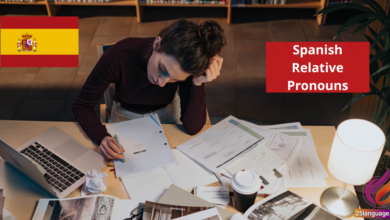How to Use the Past Perfect

Imagine you’re telling a story about your childhood experiences, but you want to clarify actions that happened before other past events. Enter the past perfect tense, or “pluscuamperfecto,” a powerful tool in Spanish that allows you to do just that! In this lesson, you’ll discover how to use this tense to express timelines and deepen your storytelling, enriching your conversations and making your Spanish more dynamic and precise. Let’s dive in!
Mastering the Past Perfect Tense for Fluent Communication
The past perfect tense, known as el pretérito pluscuamperfecto in Spanish, is used to describe actions that were completed before another action in the past. To form this tense, you need to use the auxiliary verb haber in the imperfect tense followed by the past participle of the main verb. Remember the conjugation of haber for this purpose:
- yo había (I had)
- tú habías (you had, informal)
- él/ella/usted había (he/she/you had, formal)
- nosotros/nosotras habíamos (we had)
- vosotros/vosotras habíais (you all had, informal in Spain)
- ellos/ellas/ustedes habían (they/you all had)
For example, the sentence Antes de que llegáramos, ellos ya habían comido. translates to “Before we arrived, they had already eaten.” Here, habían comido indicates that the eating occurred before another past event. Another example is Cuando me desperté, ella ya había salido.,meaning “When I woke up,she had already left.” It highlights that the action of leaving took place before the waking up occurred.
| Spanish Example | Rule | English Translation |
|---|---|---|
| ¿Ya habías estudiado para el examen? | Use of past perfect to inquire about a past action that could have occurred. | Had you already studied for the exam? |
| Ellos habían terminado el proyecto antes de la fecha límite. | Describes completion of a past action before another past reference point. | They had finished the project before the deadline. |
| Cuando llegué,ya habías limpiado la casa. | Expressing an action that was completed prior to another action. | When I arrived, you had already cleaned the house. |
understanding the Intricacies of Pluscuamperfecto in English
The Pluscuamperfecto, or pluperfect tense, is used to express actions that occurred before another action in the past. In Spanish, it is formed using the imperfect tense of the auxiliary verb “haber” followed by the past participle of the main verb. To create the Pluscuamperfecto, use the following rules:
- The auxiliary verb “haber” in the imperfect form: había, habías, había, habíamos, habíais, habían.
- The past participle of the main verb is formed by adding -ado for -ar verbs and -ido for -er and -ir verbs.
For example:
- “Cuando llegué, ya había salido.” (When I arrived, he/she had already left.)
- “Ella había estudiado antes del examen.” (She had studied before the exam.)
To better understand the structure, consider the following table:
| Spanish Example | Auxiliary Verb (Imperfect) | main Verb (Past Participle) | English Translation |
|---|---|---|---|
| Nosotros habíamos comido. | habíamos | comido | We had eaten. |
| Ellos habían terminado el trabajo. | habían | terminado | They had finished the work. |
| Yo había visto esa película. | había | visto | I had seen that movie. |
In practice, the Pluscuamperfecto is frequently enough used in storytelling, contrasting events, and providing context for past discussions. It paints a clearer picture of the sequence of events, showcasing the rich nuances of the Spanish language.
Practical Applications and Examples of the Past Perfect Tense
The past perfect tense, known as “el pretérito pluscuamperfecto” in Spanish, is used to express actions that were completed before another action or moment in the past. This tense is formed by combining the auxiliary verb ”haber” in the imperfect tense with the past participle of the main verb. The structure is as follows:
- Imperfect tense of “haber”: había, habías, había, habíamos, habíais, habían
- Past participle: for regular verbs, add -ado for -ar verbs and -ido for -er and -ir verbs.
Such as:
- Había comido antes de salir. (I had eaten before going out.)
- Ellos habían estudiado para el examen. (They had studied for the exam.)
| Spanish Example | English Translation |
|---|---|
| Yo había visto esa película antes. | I had seen that movie before. |
| Nosotros ya habíamos comprado la cena. | We had already bought dinner. |
Enhancing Your Writing Skills with the Past Perfect Structure
The past perfect tense, known as “el pluscuamperfecto” in Spanish, is used to express actions that had occurred before another action in the past. This tense is particularly useful for adding depth to your writing, allowing you to provide context or background information. The structure consists of the imperfect form of the verb haber followed by the past participle of the main verb. Here’s the conjugation of haber in the imperfect tense:
- yo había
- tú habías
- él/ella había
- nosotros/nosotras habíamos
- vosotros/vosotras habíais
- ellos/ellas habían
To form the past perfect, combine the appropriate form of haber with the past participle. For example:
- Yo había comido antes de llegar. (I had eaten before arriving.)
- Ellos habían estudiado para el examen. (They had studied for the exam.)
Additionally, remember that the past participles of regular verbs typically end in -ado for -ar verbs and -ido for -er and -ir verbs. Irregular verbs, though, have unique past participles that must be memorized. Here’s a brief overview:
| Spanish Example | Past Participle | English Translation |
|---|---|---|
| hablar | hablado | spoken |
| comer | comido | eaten |
| vivir | vivido | lived |
| ver | visto | seen |
| escribir | escrito | written |
The Way forward
¡Bravo! Has llegado al final de nuestra lección sobre el pluscuamperfecto en español. Hoy hemos explorado cómo usar esta importante forma verbal para hablar de acciones que ocurrieron antes de otro evento en el pasado. Recordemos que el pluscuamperfecto se forma utilizando el verbo auxiliar “haber” en imperfecto, seguido del participio pasado del verbo principal.
Hemos visto ejemplos prácticos y comparaciones con el pasado perfecto en inglés, lo que te ayudará a identificar y utilizar esta estructura con confianza en tus conversaciones y escritos. La práctica es fundamental, así que te animo a que comiences a incorporar el pluscuamperfecto en tus ejercicios y diálogos diarios. Recuerda que cada nuevo aprendizaje es un paso hacia la fluidez en el idioma.
no dudes en usar tus nuevas habilidades para crear oraciones, contar historias o incluso escribir un diario. Cuanto más practiques, más natural se volverá y más cómoda te sentirás al expresarte en español. Sigue adelante y aprovecha cada oportunidad para aplicar lo que has aprendido. ¡Estás haciendo un gran trabajo y estoy seguro de que conseguirás dominar el pluscuamperfecto! ¡Hasta la próxima lección!





























